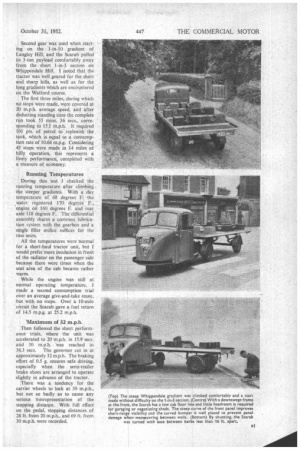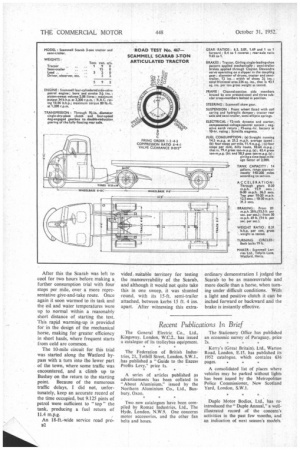A Lively, Smart and Economical Workhorse
Page 34

Page 35

Page 36

If you've noticed an error in this article please click here to report it so we can fix it.
COUPLED to a 3-ton semitrailer the Scammell three wheeled tractor is a lively and smart workhorse, with a small appetite for fuel. On test it showed a spirited performance over a hilly route, accelerated to • 20 m.p.h. in 16 secs., and worked hard with a full load for, 10-12 miles on a gallon of. fuel, Apart from. adding a vacuum servo, which is an optional fitting, for improved braking on the semitrailer, few.-changes have been made since its introduction four years ago.
For its particular function, that of ha:uling semi-trailers o-n • short : distance journeys and
manceuVring t n spaces designed for horse-drawn .traffic, the Scarab is required to be a robust and compact Unit yet accessible in
every detail. With the engine and transmission positioned behind the cab, it is a comfortable and safe vehicle to handle because most of the noise is external and the major part of the weight is supported by the rear axle, so making for improved traction better braking.
In most respects the Scarab 3and &tortners employ common components, but the engine in the smaller outfit is down-rated to afford an output of 34 b.h.p. at 3,200 r.p.m. This is arranged through the carbitretter and intake manifold. and Squat Engine The four-cylindered engine is a squat, side-valve unit, with a siluare bore-stroke ratio and a shallow dry sump. It has a Meehanite cast-iron counterbalanced crankshaft carried in white-metal bearings, and the camshaft is gear driven. A spiralbevel drive from the camshaft operates the oil pump and Scintilla magneto.
The clutch, gearbox and rear-axle assembly form an integral unit with the engine which can be detached from the main chassis by removing a large-diameter bolt from the front of the crankcase. This mounting, which includes two heavy-duty A32
rubber bushes, carries the full driving and braking torque.
A feature of the transmission is the arrangement of the drive, the pinion of the final-drive unit being fitted integrally with the gearbox output shaft. The driving axle is secured to the frame through semielliptic springs bearing against slippers carried in brackets attached to the ramp pressing. When taking the power and transmission unit from the frame, the assembly is released at the rear by removing the front security bolts under the springs in the slipper brackets.
The front suspension employs an oil-immersed single coil spring, in conjunction with an integral damper. Movement of the front wheel is transmitted to the spring through a cranked lever, and a damping effect is attained by incorporating a fixedsized-orifice valve in the oil bath. The steering is linked to the front wheel through a skew gear, which is enclosed in a casting together with the steering shaft, the -casting being secured to the front tubular crossmembers.
Girling single-leading-shoe units are fitted to both tractor and load carrier, and on the test vehicle the semi-trailer braking system was assisted by a Clayton Dewandre vacuum servo. The balance of braking effort between the two units is obtained by using a large-diameter control valve, and the brakes on the carrier are applied through a pin in-the coupling gear which actuates a slipper and bell-crank Wrier.
To provide easy access to the cab, the chassis frame is downswept at the middle, which affords a low floor line and the driver is able to step straight off -the road into the cab. Air is drawn through a duct in the side of the cab to cool the radiator, and by this means the tubes are kept free from exterior fouling. The cab is an all-steel structure with removable panels at the rear to make the radiator accessible.
For the consumption trials, a funnel-neck tank • was provided in addition to the standard petrol tank, and this was filled before leaving the works. Because, in its normal role, the Scammell has to make many journeys starting from cold, my fuel tests were made under similar conditions.
Our " Electric " Route It was first driven to the Watford Junction railway sidings, which are within a mile of the Scammell works, and after topping-up the tank I conducted an economy run over the hilly route used for battery-electric vehicle trials. The first three miles were covered without stops, after which a 15-sec. halt was made every quarter of a mile. The Scarab rode comfortably at 28-30 m.p.h. in the first section and then it encountered the hills.
Second gear was used when starting on the 1-in-10 gradient of Langley Hill, and the Scarab pulled its 3-ton payload comfortably away from the short 1-in-5 section on Whippendale Hill. I noted that the tractor was well geared for the short and sharp hills, as well as for the long gradients which are encountered on the Watford course.
The first three miles, during which no stops were made, were covered at 20 m.p.h. average speed, and after deducting standing time the complete run took 55 mins. 36 secs., corresponding to 15.1 m.p.h. it required 101 pts. of petrol to replenish the tank, which is equal to a Consumption rate of 10.64 m.p.g. Considering 45 stops were made in .14 miles of hilly operation, this represents a lively performance, completed with a measure of economy.
Running Temperatures
During this test I checked the running temperature after climbing . the steeper gradients. With a day temperature of 68 degrees F; the .water registered 170 degrees F., engine oil 160 degrees F. and rear axle 118 degrees F. The differential assembly shares a common lubrication system with the gearbox and a single filler orifice suffices for the two units.
All the temperatures were normal for a short-haul tractor unit, but I would prefer more insulation in front of the radiator on the passenger side because there were times when the seat area of the cab became rather warm.
While the engine was still at. normal operating temperature, I made a second consumption trial over an average give-and-take route, but with no stops. Over a 10-mile circuit the Scarab gave a fuel return of 14.5 m.p.g. at 25.2 m.p.h.
'Maximum of 32 m.p.h.
Then followed the short performance trials, where the unit was accelerated to 20 m.p.h. in 15.9 secs. and 30 m.p.h. Was reached in 36.3 secs. The governor cut in at approximately 32 m.p.h. The braking effort of 0.5 g. ensures safe driving, especially when the semi-trailer brake shoes are arranged to operate slightly in advance of the tractor.
There was a tendency for the carrier wheels to lock at 30 m.p.h., but not so badly as to cause any serious misrepresentation of the stopping distance. With full effort on the pedal, stopping distances of 28 ft. from 20 m.p.h., and 69 ft. from 30 m.p.h. were recorded. After this the Scarab was left to cool for two hours before making a, further consumption trial with four stops per mile, over a more representative give-and-take route. Once again it soon warmed to its task and the oil and water temperatures were up to normal within a reasonably short distance of starting the test. This rapid warming-up is provided for in the design of the mechanical horse, making for greater efficiency in short hauls, where frequent starts from cold are common.
The 10-mile circuit for this trial was started along the Watford bypass with a turn into the lower part of the town, where some traffic was encountered, and a climb up to Bushey on the return to the starting point. Because of the numerous traffic delays, I did not, unfortunately, keep an accurate record of the time occupied, but 9.125 pints of petrol were sufficient to " top " the tank, producing a fuel return of 11.4 m.p.g.
An 18-ft-wide service road pros2
vided suitable territory for testing the manceuvrability of the Scarab, and although it would not quite take this in one sweep, it was shunted round, with its I5-ft. semi-trailer attached, between kerbs 15 ft. 4 ins. apart. After witnessing this extra
ordinary demonstration I judged the Scarab to be as manteuvrable and more docile than a horse, when turning under difficult conditions. With a light and positive clutch it can' be inched forward or backward and the brake is instantly effective.












































































